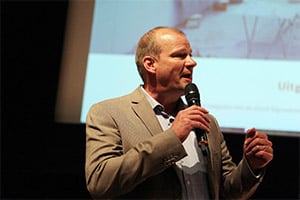Developing Public Speaking Skills in Students
Author: Joshua Covey
September 14, 2016

In a famous stand-up comedy bit, Jerry Seinfeld jokes about people’s fear of public speaking:
“I saw a study that speaking in front of a crowd is considered the number-one fear of the average person. I found that amazing. Number two was death. Death is number two? This means, to the average person, if you have to be at a funeral, you would rather be in the casket than doing the eulogy.”
Psychologists attribute our fear of public speaking to our fear of being ostracized from a group, which thousands of years ago meant imminent death by a large predator.
However, with preparation, practice, and experience, people can overcome their fear, build confidence, and deliver strong speeches.
Several years ago, I was asked to give a speech at a Leader in Me School. The crowd was large and I felt a little nervous. Right before I went on stage, the prior speaker gave an amazing speech about a service project he had completed. He used PowerPoint slides effectively; he wore a tie; he had amazing presence; and he was in first grade! It almost felt comical when I said to myself, “If this first grader can do it, then I can do it too!”
In our modern world, the ability to present to an audience is a crucial leadership skill. In Leader in Me Schools around the world, children are encouraged to build and practice their public-speaking skills. There are three basic components to a successful speech.
The first key is for the speaker to relate to the audience. How can you connect with the audience’s needs and interests? If you don’t do that, then your message will have little impact on them. What stories, metaphors, statistics, jokes, or examples can you share that will help people relate to and care about your message?
The second key is presenting a clear and well organized message. Have you ever listened to a speech or presentation, and when it is
finished, you can’t even recall the main idea? A well-organized speech—like a good essay—has a main theme or idea and then provides supporting points and details.
The third key is for the message to be delivered dynamically. You want to have inflection in your voice and communicate with body language, such as good posture, eye contact, facial expressions, and hand gestures. Delivery skills can be learned and practiced.
To summarize, there are three basic components of a successful speech:
- Relating to your audience
- A clear and organized message
- Dynamic delivery
If you’d like to see all three of these components illustrated, watch the speech above by Zhorie’l Tapo of the first grade, who was a winner in the 2016 Leader in Me Student Speech Contest.
Now that you have seen the basics of making a good speech illustrated by a young student, the question is: “How we can teach these skills to all students?”
There are many opportunities for students to practice speaking skills. For example, there are formal opportunities such as when students do projects and make a presentation to the class, or school assemblies, or a classroom event. There are also many informal opportunities when students simply share their thinking or ideas in class.
In both cases, teachers can create a high standard for oral presentations and then hold students to those expectations throughout the year.
Teachers should not be afraid to intervene and coach students on how they can more effectively communicate. For example, I have seen teachers in Leader in Me Schools stop a speech in the middle of a sentence and say, “Let’s work on your speech delivery right now. Let’s try speaking louder so people in the back can hear you, and let’s make eye contact with the different sections of the room so people feel you are talking to them. Please try that last paragraph one more time.”
When I visited the Ron Clark Academy, teachers were constantly correcting students in the classroom and helping them refine their oral communication. “Stand up straight with good posture.” “Stay on topic and avoid tangents.” “Speak clearly rather than slurring your words.” These were the types of comments I heard, given in the spirit of improvement.
Teachers consistently give feedback on written communication, on math, and on all types of other skills, so why not consistently give feedback on oral communication as well? It’s certainly a foundational skill that is necessary for success. And who knows, maybe when the next generation of students grow up, they will fear death more than public speaking.
Share Article on
Tags: 21st century education, 21st century skills, leadership roles, student empowerment, Student Engagement, student leadership, student potential, The Leader in Me, whole-child education
